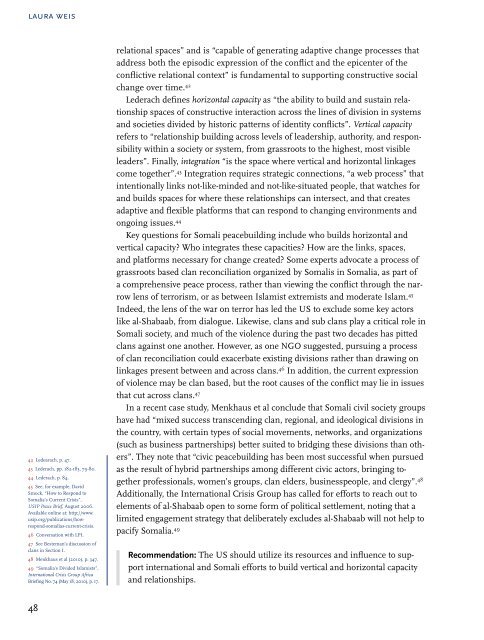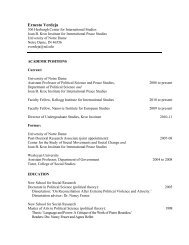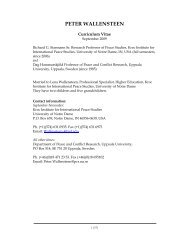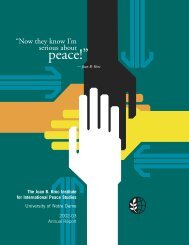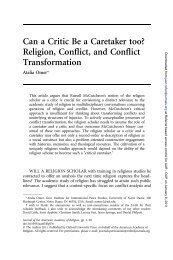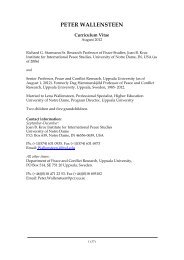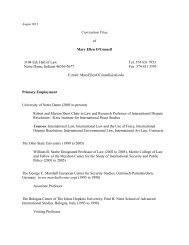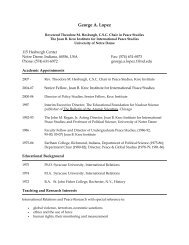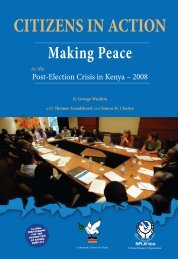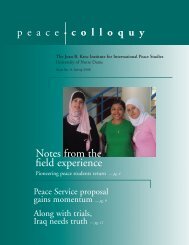Somalia: Creating Space for Fresh Approaches to Peacebuilding
Somalia: Creating Space for Fresh Approaches to Peacebuilding
Somalia: Creating Space for Fresh Approaches to Peacebuilding
You also want an ePaper? Increase the reach of your titles
YUMPU automatically turns print PDFs into web optimized ePapers that Google loves.
laura weis<br />
42 Ledearach, p. 47.<br />
43 Lederach, pp. 182-183, 79-80.<br />
44 Lederach, p. 84.<br />
45 See, <strong>for</strong> example, David<br />
Smock, “How <strong>to</strong> Respond <strong>to</strong><br />
<strong>Somalia</strong>’s Current Crisis”,<br />
USIP Peace Brief, August 2006.<br />
Available online at: http://www.<br />
usip.org/publications/howrespond-somalias-current-crisis.<br />
46 Conversation with LPI.<br />
47 See Besteman’s discussion of<br />
clans in Section I.<br />
48 Menkhaus et al (2010), p. 347.<br />
49 “<strong>Somalia</strong>’s Divided Islamists”,<br />
International Crisis Group Africa<br />
Briefing No. 74 (May 18, 2010), p. 17.<br />
48<br />
relational spaces” and is “capable of generating adaptive change processes that<br />
address both the episodic expression of the conflict and the epicenter of the<br />
conflictive relational context” is fundamental <strong>to</strong> supporting constructive social<br />
change over time. 42<br />
Lederach defines horizontal capacity as “the ability <strong>to</strong> build and sustain relationship<br />
spaces of constructive interaction across the lines of division in systems<br />
and societies divided by his<strong>to</strong>ric patterns of identity conflicts”. Vertical capacity<br />
refers <strong>to</strong> “relationship building across levels of leadership, authority, and responsibility<br />
within a society or system, from grassroots <strong>to</strong> the highest, most visible<br />
leaders”. Finally, integration “is the space where vertical and horizontal linkages<br />
come <strong>to</strong>gether”. 43 Integration requires strategic connections, “a web process” that<br />
intentionally links not-like-minded and not-like-situated people, that watches <strong>for</strong><br />
and builds spaces <strong>for</strong> where these relationships can intersect, and that creates<br />
adaptive and flexible plat<strong>for</strong>ms that can respond <strong>to</strong> changing environments and<br />
ongoing issues. 44<br />
Key questions <strong>for</strong> Somali peacebuilding include who builds horizontal and<br />
vertical capacity? Who integrates these capacities? How are the links, spaces,<br />
and plat<strong>for</strong>ms necessary <strong>for</strong> change created? Some experts advocate a process of<br />
grassroots based clan reconciliation organized by Somalis in <strong>Somalia</strong>, as part of<br />
a comprehensive peace process, rather than viewing the conflict through the narrow<br />
lens of terrorism, or as between Islamist extremists and moderate Islam. 45<br />
Indeed, the lens of the war on terror has led the US <strong>to</strong> exclude some key ac<strong>to</strong>rs<br />
like al-Shabaab, from dialogue. Likewise, clans and sub clans play a critical role in<br />
Somali society, and much of the violence during the past two decades has pitted<br />
clans against one another. However, as one NGO suggested, pursuing a process<br />
of clan reconciliation could exacerbate existing divisions rather than drawing on<br />
linkages present between and across clans. 46 In addition, the current expression<br />
of violence may be clan based, but the root causes of the conflict may lie in issues<br />
that cut across clans. 47<br />
In a recent case study, Menkhaus et al conclude that Somali civil society groups<br />
have had “mixed success transcending clan, regional, and ideological divisions in<br />
the country, with certain types of social movements, networks, and organizations<br />
(such as business partnerships) better suited <strong>to</strong> bridging these divisions than others”.<br />
They note that “civic peacebuilding has been most successful when pursued<br />
as the result of hybrid partnerships among different civic ac<strong>to</strong>rs, bringing <strong>to</strong>gether<br />
professionals, women’s groups, clan elders, businesspeople, and clergy”. 48<br />
Additionally, the International Crisis Group has called <strong>for</strong> ef<strong>for</strong>ts <strong>to</strong> reach out <strong>to</strong><br />
elements of al-Shabaab open <strong>to</strong> some <strong>for</strong>m of political settlement, noting that a<br />
limited engagement strategy that deliberately excludes al-Shabaab will not help <strong>to</strong><br />
pacify <strong>Somalia</strong>. 49<br />
Recommendation: The US should utilize its resources and influence <strong>to</strong> support<br />
international and Somali ef<strong>for</strong>ts <strong>to</strong> build vertical and horizontal capacity<br />
and relationships.


